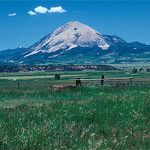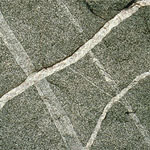
|
| The liquid phase of most materials is less dense than the solid phase. Thus, molten rock (magam) is less dense than solid rock. When a body of magma forms deep beneath the Earth's surface, it tends to rise buoyantly like a hot air balloon rising through the atmosphere.
How far the magma rises depends on its density compared to the rocks it is passing through. As the magma rises through the Earth's crust, the solid rock around it becomes less and less dense. Thus, many rising magmas eventually find themselves surrounded by solid rock with the same density as the magma. In such cases, the magma stalls and ponds beneath the Earth's surface. The cooling magmas produce a range of igneous textures, depending on the cooling history and geometry of the intrusive body. Large intrusive bodies, termed plutons, tend to cool slowly and make coarse-grained textures. Dikes and sills, forming from thin sheets of magma pushing along cracks, cool much more quickly. Pegmatites also cool fairly quickly, but their high water content promotes rapid crystal growth and thus very coarse textures. |
|
Photo: White Mountain Pluton by Norris W. Jones |
 |
|
 |
![]()
|
|
|